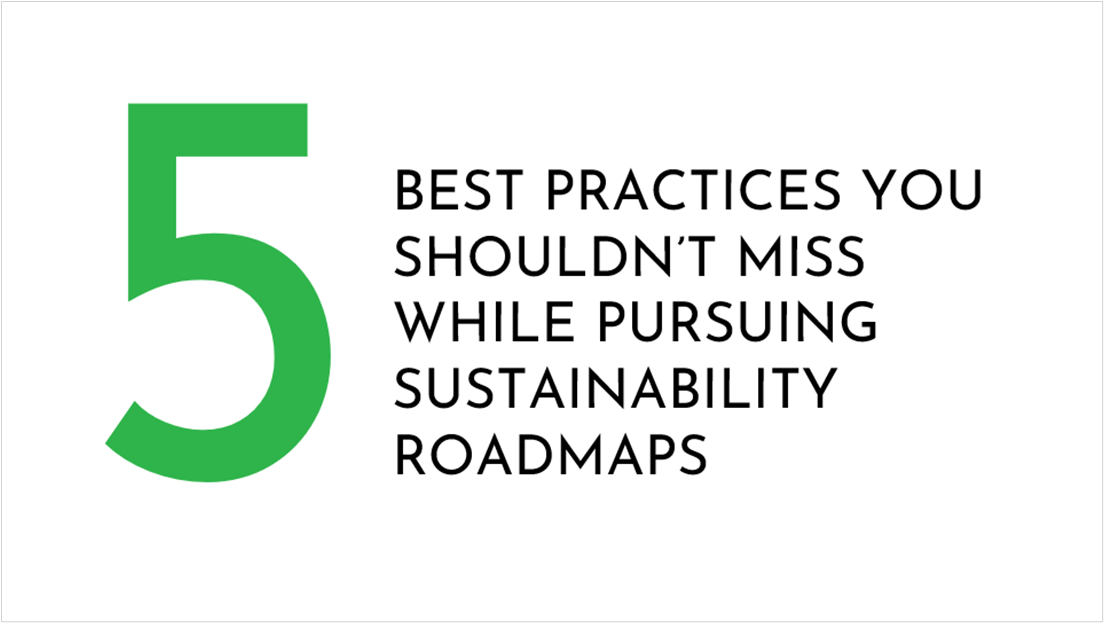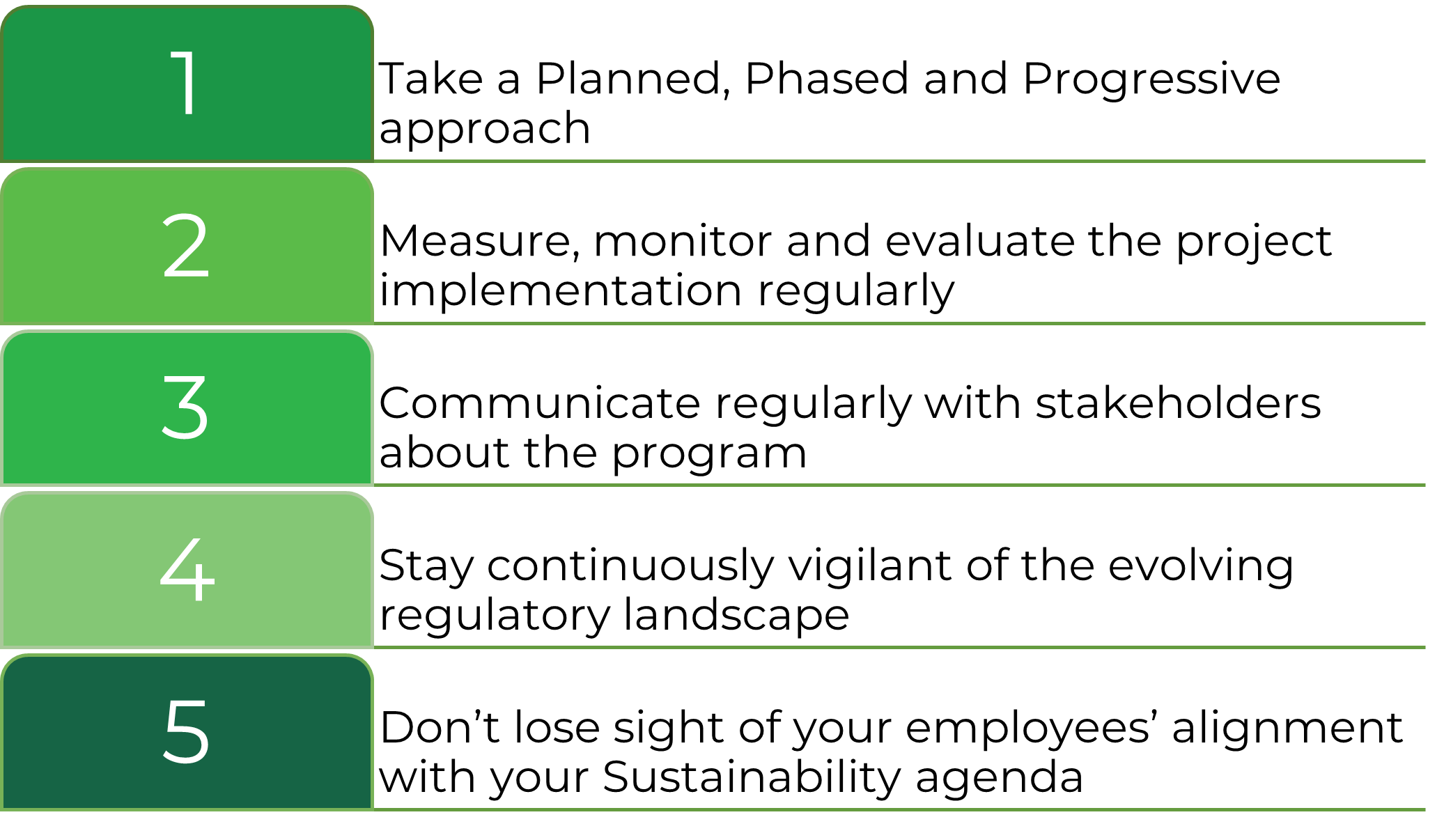
Enterprises that have planned out their Sustainability strategy will be keen to progress into implementation to witness some of the desired results. While this is an encouraging sign, pursuing the sustainability roadmaps should be done with thorough due diligence for each project/initiative. At the outset, it must be understood that implementation of Sustainability Roadmaps is complex due to more reasons than one
- Multiple stakeholders involved at various junctures of the program
- Multi-dimensional approach required for 360-degree approach to Sustainability
- Multi-year program considering the broad scope of Sustainability roadmaps
In complex programs like these, a wrong step could have wide-ranging repercussions. In order to avoid those unpleasant situations, we detail our 5 best practices that you need to have in your armoury for a successful implementation of the program.

1. Take a Planned, Phased and Progressive approach
The 3Ps mentioned here are the mantras for a well-structured sustainability roadmap. A significant part of this would be already addressed during the planning of the Sustainability Roadmap. It only needs to be emphasised a lot more during the implementation. Let us understand what a Phased approach looks like.
a. Phased Emissions - Scope 1, Scope 2 and then Scope 3
It is common understanding that Scope 3 emissions are a tough nut to crack. This is because of the dependency on external stakeholders across your value chain to work with you on your Sustainability Roadmap. This involves significant effort and hence should be considered only after you have done a GHG Inventory and Emissions calculation for Scope 1 and 2 emissions. The data inputs required for Scope 1 and 2 should be available well within your reach. So, tackle this first and demonstrate results. This could give you the required experience and confidence to approach your external stakeholders for addressing Scope 3 emissions.
b. Phased Mitigation Hierarchy
Right alongside the phasing of emissions comes the phasing as per the Mitigation Hierarchy. To begin with, focus on projects that help your enterprise Avoid and Reduce emissions across the value chain. These projects should sit on the top priority list and the results from these projects should help arrive at the residual emissions that are unavoidable. It is this outstanding or residual emissions that should then be neutralized through Removal and Offset initiatives. Companies should follow the mitigation hierarchy to steer clear of Greenwashing.
c. Phased Stakeholder Onboarding
In a multi-stakeholder program, it is important to build a stakeholder matrix (Power vs Interest) and identify the key stakeholders through such an exercise. In a phased manner, onboard the key stakeholders on your Sustainability Roadmap by delivering outcomes that matter to them. Gradually, onboard the other stakeholders and gain their confidence too.
d. Phased Standards/Frameworks Adoption
The Sustainability and ESG space is occupied by multitude of standards, frameworks, programs and regulations. While each has its own merit, it is not easy for the enterprise implementing the sustainability roadmap to align with all of them. It is important to identify the ones that you want to align with initially and leverage this work to gradually align with the other standards. For example, SBT commitments could be declared with the SBTi, early in the roadmap. As one progresses towards the targets, it provides enough credible evidence to demonstrate on Sustainability Reporting standards like the CDP.
2. Measure, monitor and evaluate the project implementation regularly
The success of the sustainability roadmap will depend solely on the results achieved through the implementation of projects/initiatives. It is important that each project has its clearly documented Monitoring and Evaluation (M&E) framework. This framework should identify the outputs, outcomes and impact expected from the project. Such a framework should have a multi-dimensional perspective to give enough consideration to People and Planet implications.
With such a framework in place, it is important to have the implementation team constantly measure the progress to confirm adherence to timelines. This further helps monitor the health of the project and contributes to the health of the overall program. Further, this should help in evaluation of the project results against the documented outputs, outcomes and impacts in the M&E framework.
It is important to consider the measurement, monitoring and evaluation as integral to the ongoing project management activities. These should not be left for the fag-end of the projects, to give the project team enough opportunity for course corrections, where required.
3. Communicate regularly with stakeholders about the program
In any complex program, communication with stakeholders is key. They need to be constantly briefed on the progress achieved and importantly, they need to gain confidence with each passing milestone. The nature and style of communication could vary depending on the stakeholders under consideration
a. Submit regular reports for third-party validation and verification
These could be for validation of SBT progress by SBTi, assurance of your program results by Audit/Assurance organization etc. In cases where your projects are registered for carbon credits, the DOE (Designated Operational Entity) would need regular communication in pre-defined formats.
b. Communicate with external stakeholders
These communications could be with regulatory authorities where one needs to submit reports cyclically in a standard template. The external stakeholders would also involve your value chain participants. It helps to keep them aware so that they could anticipate any potential change coming their way and prepare for it before-hand.
c. Communicate with internal stakeholders
The internal stakeholder mix includes Senior Leadership, Mid-management and Employees. Your internal communication channels could be leveraged well to establish a stronger connect across the hierarchy with the Sustainability agenda of the enterprise.
4. Stay continuously vigilant of the evolving regulatory landscape
While Sustainability Roadmaps are long running, it must be remembered that the regulatory landscape on Sustainability is a state of flux too. Depending on the geographical territories in which you operate, you have to keep a constant eye on the applicable regulations. In the coming years, a significant number of regulatory norms will be announced across leading global economies. There could be potential situations where a new regulation requires you to course-correct your Sustainability roadmap or maybe an ongoing project in the roadmap.
5. Don’t lose sight of your employees’ alignment with your Sustainability agenda
This is key to ensure the success and longevity of the change you are bringing in through the Sustainability roadmap. It is a given that the implementation initiatives will aim to achieve the desired results to demonstrate success, given the extensive focus and momentum in their favour from the senior leadership. Post implementation, there are strong chances that the success diminishes and, in a few cases, reverses itself because of the dimming spotlight on the project. While one could keep dedicating resources to ensure that the successful results are not lost over time, there is a better way to achieve the same results. The answer lies in leveraging the might and strength of your people – your workforce.
Your people should be sensitized about Sustainability in a manner that they establish a stronger connect with the projects/initiatives taken up by the enterprise. A few ideas to make this work in the real world:
- Involve them in the ideation of Sustainability projects/initiatives
- Generate avenues for them to participate and contribute towards the implementation activities
- Provide opportunities for them to narrate their stories and experiences with the projects/initiatives
- and more….
These employee engagement approaches should be identified and such that they generate a behavioural shift within each individual. While it looks like a tall order, the results from this are most effective in ensuring that the change is long-lasting and sustainable.
These best practices are no silver bullets but are ways to ensure that the initial legs of your roadmap implementation are smoother. It sets an ideal platform for you to scale up your impact as you progress further and further on your Sustainability roadmap.
